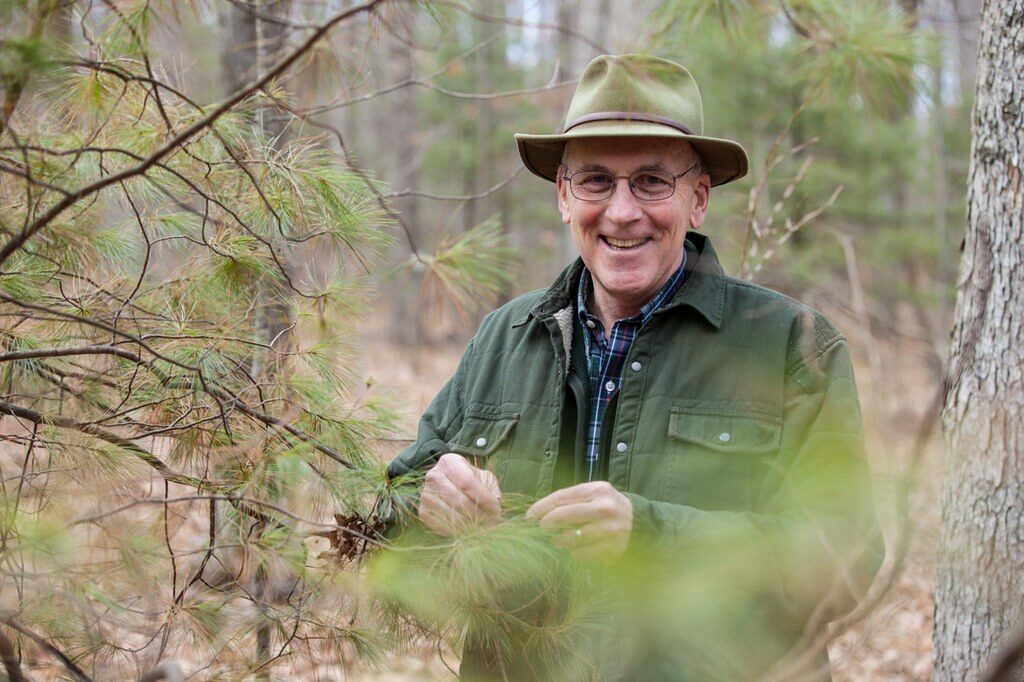Posts Tagged → forestry
PA’s Forester Jim Finley Enters the Forest Cathedral
Penn State forestry professor emeritus, department head, and all-things-forestry guru Jim Finley died yesterday. I was told that he was either felling a large tree on his property, or he was trying to dislodge a large tree that had been felled but was hung up on another tree. Whatever the actual facts are, Jim died from the tree falling on him. It is a reminder that even the best, most experienced forestry professionals are at grave risk.
As trite and awkward as it sounds to write here, the fact is that Jim Finley died doing what he loved in the environment he considered sacred. I am quite sure that had he been asked about whether he would like to die from a tree falling on him, or some more peaceful and less traumatic way, he would have given us the look he is giving below. It is that knowing “Why are you saying that, you know it is wrong” look. In his mid-70s, Jim was nowhere ready to leave us, and we were nowhere ready to let go of him.
His death is a huge loss.
Jim was a remarkable man, who I admired, and who left a way outsized hand print on Pennsylvania conservation and the practice of forestry in eastern America. He was a force to be reckoned with, an institution in his own right, a political-cultural movement, a gentle soul with a will of iron, kind and easy but also passionate and unrelenting.
He did not suffer fools easily, though he accepted honest debate and earnest dissent exactly the way an academic ought to: His eyes took on this hard laser focus, and you could tell he was actively listening and processing, not always ready to give an answer, either. His response might come tomorrow or next year, and if your argument was good, you could tell it had moderated Jim’s perspective.
Jim Finley was an academic, and sometimes prone to the idealism that academics naturally grow into. However, he also had the ability to be hands-on practical, and even more important, he had the ability to support aggressive, hands-on, totally practical forestry practices. You know, the kinds of visual impacts that most urbanites recoil in horror from, and which many land conservation groups really did not want to see, either, no matter how scientifically they were needed or justified. It is an admirable and rare trait to be able to be honest about unpleasant things, and Jim could look at a heavily cut tract with tree tops lying all over the place, and cheerfully explain all of the wonderful things that were now going to follow on the heels of all that disturbance. Because of Jim, conservation easements in Pennsylvania are now a lot more forestry-friendly than they used to be. And a landowner who is able to manage his or her forest as aggressively as they need to under a conservation easement, is a landowner who is much more likely to sign that easement and protect their land in the first place.
Jim invited me to speak to his classes a couple of times, and we worked together when I was at DCNR and the Conservation Fund. I knew him when I was a kid in State College, I knew him as a professional forester and academic at Penn State, and I knew him as a colleague of land conservation legend and Penn State forester Joe Ibberson, whose PSU forestry department endowment Jim presided over at the end of his formal career. It is always a huge loss when someone of Jim’s high caliber leaves us, but it is even more so when he was just starting to become mature, as he would put it in the terms of a tree.
So long, old friend. Happy travels in your peaceful forest cathedral. We who are left behind mourn your untimely departure and we will miss you greatly. You were a hell of a guy, Jim.
Forestry 101
“Clearcutting” forests has become a no-no idea, a bad word with most people. Whether it was environmental advocates or ripped off landowners who said it was wrong, it’s not clear.
Nothing could be farther from the truth. “Select cut” forestry is usually the worst thing you can do, because it takes the best and leaves the rest. Worst-first is the by-line of sound forestry. Clearcutting removes a great deal of the forest canopy so that other trees and plants may grow.
It’s true that I have seen failed clearcutting, but out west, where the thin soils, steep slopes, and dry conditions leave forests at risk from too much canopy removal. Those conditions rarely apply to the northeast or the south.
Recently I contracted Lyme Disease, for the third or fourth time. It’s my guess that ticks are growing in number and area because forest fires have been artificially suppressed for so long. Short of controlled burns, clearcutting is as close as we can get to mimicking the cleansing effect of a forest fire.
If you have forest land and you want to manage the timber, don’t be afraid to clearcut it, if the trees there support that management tool.


